POLL: How do you keep your home cool in summer?
With Australia heading into summer, an unrelenting period of heat and dryness, we often look to our homes to keep us cool. Frustratingly, many cooling solutions come at a price, so we've listed some handy tips on keeping your summer electricity bill down, here.
Vote for your favourite cooling solution below and tell us how it keeps your home cool.
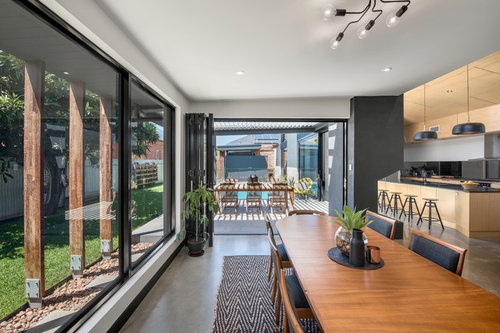
Commentaires (29)
Olivia Stuckey
il y a 4 ans@oklouise i wish i had the luxury of being able to change the orientation of my home, but unfortunately I have to resort to a fan and fresh air haha
Protek window tinting & blinds
il y a 4 ansWindow tinting with a good solar film which can also offer improved glass insulation for heat retention for the colder periods as well as adding privacy if required without closing blinds /curtains etc and offers good fade protection /glare reduction and glass security all in the one packaging .
Added ceiling fan offers an added benefit for both summer and winter months and cost effective way to circulate the air flow as open windows can be problematic at times where security and noise is a factorddarroch
il y a 4 ansLike oklouise said, the home's orientation. Wish it was on the poll (not just "our home doesn't get hot". As orientation plays such a big part in keeping a home cool in summer (& warm in winter), & lowering energy bills.
Kate
il y a 4 ansI’m in Melbourne so evaporative gives me option of just running fan and leaving on auto overnight so it turns off as outside air cools, it also needs windows open so you get airflow. But i also close blinds to keep out sun, and have been upping insulation as we renovate. Bedroom s on south side so they stay cooler allowing a warmer thermostat setting
Fremantle Door and Window Company
il y a 4 ansWhen changing the orientation of your home is not an option: Louvre Windows might be!
Louvres are designed to admit air and light while maintaining privacy and to keep the rain, direct sun and noise out. Galleries consist of adjustable, angled horizontal blades allowing a wider opening than a standard window ensuring Maximum airflow.
Blades that are made from an Obscure E or Low E Solar Glass are energy efficient, minimising need for air conditioning which means you save money cooling your home.
"Can I leave them open at night? What about flies and mosquitoes?"
I am glad to hear you ask.
A security mesh can be fitted to the Louvre galleries to ensure your pets remain indoors and insects remain outdoors without reducing your visibility, making them safe for open nights.
One final reason to consider Louvres an option for your home is they look great and are currently on trend, thus adding value to your home.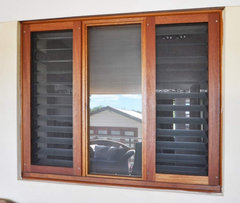
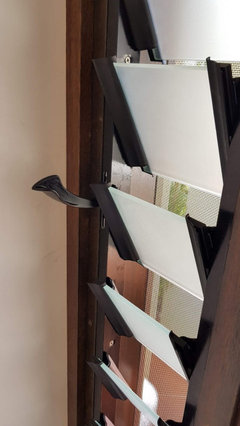
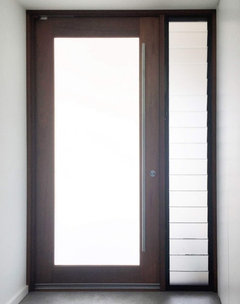
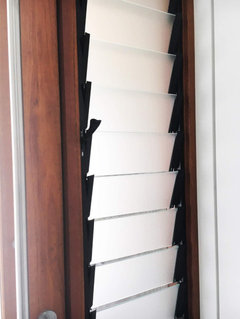
Sara Graham
il y a 4 ansIn our new place (move in November) orientation, insulation, external shading, ceiling fans and cross ventilation with aircon for extreme days, powered by solar panels. Aircon installed for heating in winter as we are all electric and it’s the most efficient form of heating.
In our current place, aircon and fans and icypoles.Kim G
il y a 4 ansWe can't change our home's orientation, or grow trees very quickly, so instead, we've used external shading. It's done wonders for us.
We live above Palm Springs, California, and when we moved here, I noticed a lot of homes and businesses had "sun sails" up. I didn't even know they were called sun sails! They looked like colorful, angular tarps, essentially.
I used Amazon reviews to find ones that lasted a long time, and we set them up over our east and west facing windows. They actually look nice on the home. The difference is immediate. Shading the exterior of our east facing windows resulted in our home staying about 10 degrees F cooler. We added ones on the west, and extended them over an area of the house with inadequate insulation. You can feel the difference on the inside of the shaded portion of exterior wall. The shaded windows also stay much, much cooler. They are metal, double pane, but without the sun sails they become burning hot to touch. With the sun sails up, you can leave your hand touching the metal.
This solution was very affordable, and our sun sails have lasted three seasons so far, in extreme winds as well as sun. Although 10F degrees difference may not seem like much, it is for us. Our region hits 115F (over 46C) several times each summer, and is consistently over 105F. Every degree counts when you are in an area that gets over 100F.debraewood
il y a 4 ansWe have generous eaves, proper orientation, window tinting, double glazing, excellent insulation, outside drop blinds where there are large areas of glass that cop most of the morning and daytime sun in summer, inside blinds plus curtains on most of the windows, cross ventilation in most rooms, Dyson fans for the bedrooms and living areas. Installed refrigerated air-conditioning with solar power. We also have large blinds to pull out over the outside decks, which does keep the house cooler. I didn't put in ceiling fans, as the house has very high ceilings and I didn't want to have to climb ladders to clean them in my old age.
Rowlands Architecture Design Studio
il y a 4 ansStart with orientation and good passive techniques using thermal mass and ventilation (if you are designing a new space). Only resort to mech in the extreme conditions during heat waves etc.
Sars
il y a 4 ansA flawed poll as you should be using multiple of these options. Good orientation if a new build, shading trees, double glazed thermally broken windows, window coverings, insulating correctly, fans, airflow, and for those really hot days a split system air con.
Olivia Stuckey
il y a 4 ans@Sars I believe the poll is asking what your favourite option is not which one do you use in your home. But I agree, many options should be used together to create an effective cooling system in the home
User
il y a 4 ansDernière modification :il y a 4 ansTips for keeping cool: If you're installing air conditioning, ensure the unit is not under-dimensioned. If the recommended capacity is borderline between one size or the next, opt for the larger capacity unit. The initial outlay for the smaller unit may be less but it will cost in the long run. A larger unit won't struggle as much, particularly on very hot days. The longevity of the unit will be improved, and running costs will be less.
To improve efficiency and minimise the running costs of your AC unit, it's important to clean the filters regularly. It's very easy, but if you're unsure check a 'how to' post on YouTube.
Set the temp at 24C. If you're uncomfy, increase the fan speed before lowering the temperature setting. Increased air flow will make you feel cooler, and it's cheaper than making the air con achieve a lower temp. If it's not overly hot, try the fan only mode. It may be all you need to feel comfortable.
If you have a ducted evaporative system and it's cooling effect has declined, the pads may need replacing. It can make a huge difference!
If you engage an architect to design your ideal home, insist that they consult with an air conditioning professional/qualified refrigeration mechanic. Many modern, flat roof designs fail to include sufficient space in the roof cavity for AC duct work and fan motors. This leaves the owner with the added expense of customized, external, metal ductwork. Or the expense and visual impact of multiple split systems.
Happy summer, everyone!
ibissue
il y a 4 ansAgree, flawed poll. Orientation, insulation, trees, shade structures are the basis..... ceiling fans are fundamental in summer. Air con used in specific room very rarely...... mainly on those hot humid February nights.
Somfy Australia
il y a 4 ansShading your home during the day to keep the heat out is an energy efficient way of cooling your home during summer. By motorising your blinds, curtains, awnings or shutters, you can set them to a schedule to open and close at set times, or use temperature sensors, so they can lower when the temperature outside reaches a certain threshold!
suancol
il y a 4 ansavoid ducting systems since they keep your attic area more liveable thus wasting cooling and heating. use a through the wall system which cools the immediate room than has a flow on effect to other areas. Plan new homes with closing off ability to cool or heat one area vs whole house.
User
il y a 4 ansDernière modification :il y a 4 ansHi suancol,
I think the type of air conditioner you’re referring to as “through the wall system” is a split system; sometimes called a wall hung split. Ducted systems and split systems both have their own pros and cons.
If cooling or heating your entire home is your main priority and initial cost isn’t really a problem then a ducted air conditioner is the better option. Whilst there is some heat transfer through the ductwork located in the ceiling cavity, it doesn’t blow air into the cavity to make it “liveable”. There’s something wrong if it does. To minimise the loss or gain of heat through your ductwork, ensure it is of high quality with a high insulation rating.
A ducted unit will have one outdoor unit and flat, unobtrusive, ceiling mounted vents/outlets, or smart looking linear slot diffusers in each room. If a ducted system is dimensioned, zoned, and operated correctly, it can achieve comparable running costs to a split system.
If you only need 1 or 2 rooms air conditioned, then properly dimensioned split systems can do the job. Unless it’s a multi-head unit, you will need space for an outdoor unit for each split system, and a boxy wall mounted unit inside each room. Multiple units means multiple running costs and multiple maintenance costs.
Depending on the installation type required for the split system, you may also have a visible pipe run on the wall, enclosed in conduit. It may also need a condensate pump to ensure water doesn’t drip into the room; which is an added expense.A cooling/heating flow on effect to other rooms is possible from a split system, but the effectiveness depends on the location of the indoor unit, the room sizes and their proximity, and where their doorways are in relation to the AC. The unit will need to be over-dimensioned (ie, have a larger kW capacity) than required for the room in which it is located. Otherwise, the unit will constantly struggle to achieve the set temperature, run more often, cost more to run, and ultimately reduce the lifespan of the unit.
Closing off parts of the house has advantages and disadvantages as well. If you’re not going to use those rooms, fine. But if you come home to a 40C bedroom, with a split system located in a different room, it will take a long time and significant power to reach comfort level, if it does at all.
The best advice is to seek advice from a professional, qualified refrigeration mechanic to properly assess the options and required capacity of the unit.
If your ducted system, or that of a friend, is achieving a “liveable” temperature in the roof space, I suggest the unit needs a service, including a thorough inspection of the ductwork for leaks or tears.singwell
il y a 4 ansI live in Qld so I have painted my roof & house white to reflect sun & put in solar powered roof fans to extract hot air from roof cavity as well as good insulation, this has made a big difference & I get many comments about how cool our home is.
User
il y a 4 ansThanks, singwell. We’re looking at systems to extract hot air from the roof cavity but we were wondering how effective they’d be. Our roof cavity gets so hot, hot water comes from the cold tap. A couple of whirlie birds is proving totally useless. If you don’t mind me asking, who makes your system?
Belle
il y a 4 ansOur roller shutters protect us from harsh weather elements. Never fails. The shutters keep our home cool during the summer and warm during winter. Plus points for keeping clouds of dust out.
3DA Design Drafting and 3D Visuals
il y a 4 ansIf all fails then grab a hose and spray the walls and roof.. it will cool down quickly.. check water restrictions first
singwell
il y a 4 ansHi Dm Stan,
My solar roof fan is made by “Sola Tube” & yes that’s the correct spelling, its very effective but not cheap it’s now 5yrs old & it’s still going fine, we’re very happy with it along with the good insulation
User
il y a 4 ansThanks, singwell. After your thumbs up, I think we’ll revisit the idea. The promotional material on the extraction systems claims they can reduce the roof cavity temp by as much as 30C. That has to be worth it. Ta!
Protek window tinting & blinds
il y a 4 ansFurther to some previous comments I’ve made over the past few years on various subject matters ; anyone that would like some further detailed information on the subject on sun control window insulation films as an option to consider for improving both heat loss and heat gains through windows ( also referred too as window tinting and / or glass tinting ) , including glass security /glare control / fade protection and decorative glass treatments etc can check out some articles I had printed in the “ The Owner Builder “ magazine no’s 180 & 181 ( Dec-Feb 2013-2914 editions )
It may help those understand a little better the product for those having various issues, such as this present subject matter on cooling methods , in this comment section .
As others have mentioned, one product may not solve all their particular problem/s and quite often more than one product / solution may often be required to obtain a better outcome .
I’ve found a lot of problems start initially with overall buildings design , orientation and the amount of glass / windows used and their sizes /design and type / amount of insulation used overall .
Having been in the window tinting industry for
about 38 years now and covering both domestic and commercial buildings , I’ve noticed how the weather patterns changed to an extent that the solutions/ products that may have been available / used some 30 odd years ago ; now have new and updated products / solutions on offer .
One can email me for further advice to clarify some issues . Although I’m a Tasmanian based business, I’ve lived and worked all around Australia and spent over 5-1/2 years in north Qld so do have some experience living in different climates .Coldstream Services
il y a 4 ansDernière modification :il y a 4 ansAir conditioners have become an essential item for many homeowners who are finding the summer hotter and winter colder. Ducted air conditioning is one of the best and most practical ways to cool your entire home during in summer. Ducted air conditioning throughout your home can provide you with many benefits. These systems use alot less internal space (you don’t have systems hanging on the wall) so its much better for aesthetic purposes. Energy efficiency, quiet to run, durability and the ability to control the temperature in individual rooms are all advantages of a ducted air conditioning system.For those deciding between ducted and a split system, ducted is beneficial for those wanting to cool the entire home rather than one or two particular areas. Installation of a ducted system does cost more in comparison to a split system, however this is due to a more complex installation that takes more time and planning.
MollyCoy
il y a 4 ansWe designed our (north facing, small) house so the summer sun stops short of the wall of windows and the winter sun comes right through to the back of the living room, heating the tiled floor until the wood fire takes over. We have one (reversible) fan and no aircon. All works perfectly well.

Rechargez la page pour ne plus voir cette annonce spécifique


oklouise